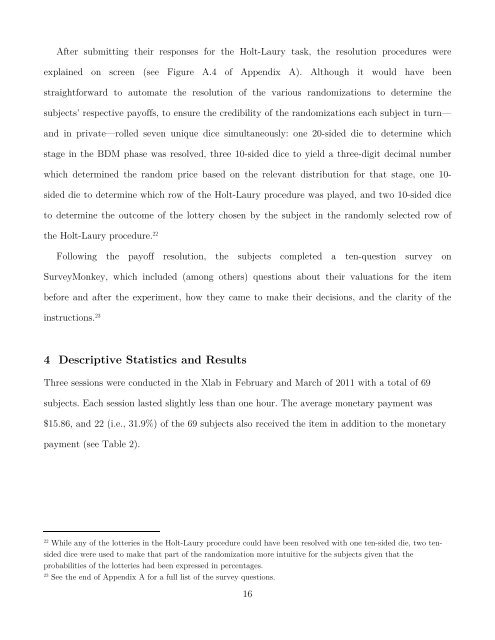Testing Distributional Dependence in the Becker-DeGroot-Marschak ...
Testing Distributional Dependence in the Becker-DeGroot-Marschak ...
Testing Distributional Dependence in the Becker-DeGroot-Marschak ...
You also want an ePaper? Increase the reach of your titles
YUMPU automatically turns print PDFs into web optimized ePapers that Google loves.
After submitt<strong>in</strong>g <strong>the</strong>ir responses for <strong>the</strong> Holt-Laury task, <strong>the</strong> resolution procedures were<br />
expla<strong>in</strong>ed on screen (see Figure A.4 of Appendix A). Although it would have been<br />
straightforward to automate <strong>the</strong> resolution of <strong>the</strong> various randomizations to determ<strong>in</strong>e <strong>the</strong><br />
subjects' respective payoffs, to ensure <strong>the</strong> credibility of <strong>the</strong> randomizations each subject <strong>in</strong> turn—<br />
and <strong>in</strong> private—rolled seven unique dice simultaneously: one 20-sided die to determ<strong>in</strong>e which<br />
stage <strong>in</strong> <strong>the</strong> BDM phase was resolved, three 10-sided dice to yield a three-digit decimal number<br />
which determ<strong>in</strong>ed <strong>the</strong> random price based on <strong>the</strong> relevant distribution for that stage, one 10-<br />
sided die to determ<strong>in</strong>e which row of <strong>the</strong> Holt-Laury procedure was played, and two 10-sided dice<br />
to determ<strong>in</strong>e <strong>the</strong> outcome of <strong>the</strong> lottery chosen by <strong>the</strong> subject <strong>in</strong> <strong>the</strong> randomly selected row of<br />
<strong>the</strong> Holt-Laury procedure. 22<br />
Follow<strong>in</strong>g <strong>the</strong> payoff resolution, <strong>the</strong> subjects completed a ten-question survey on<br />
SurveyMonkey, which <strong>in</strong>cluded (among o<strong>the</strong>rs) questions about <strong>the</strong>ir valuations for <strong>the</strong> item<br />
before and after <strong>the</strong> experiment, how <strong>the</strong>y came to make <strong>the</strong>ir decisions, and <strong>the</strong> clarity of <strong>the</strong><br />
<strong>in</strong>structions. 23<br />
4 Descriptive Statistics and Results<br />
Three sessions were conducted <strong>in</strong> <strong>the</strong> Xlab <strong>in</strong> February and March of 2011 with a total of 69<br />
subjects. Each session lasted slightly less than one hour. The average monetary payment was<br />
$15.86, and 22 (i.e., 31.9%) of <strong>the</strong> 69 subjects also received <strong>the</strong> item <strong>in</strong> addition to <strong>the</strong> monetary<br />
payment (see Table 2).<br />
22 While any of <strong>the</strong> lotteries <strong>in</strong> <strong>the</strong> Holt-Laury procedure could have been resolved with one ten-sided die, two tensided<br />
dice were used to make that part of <strong>the</strong> randomization more <strong>in</strong>tuitive for <strong>the</strong> subjects given that <strong>the</strong><br />
probabilities of <strong>the</strong> lotteries had been expressed <strong>in</strong> percentages.<br />
23 See <strong>the</strong> end of Appendix A for a full list of <strong>the</strong> survey questions.<br />
16


